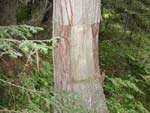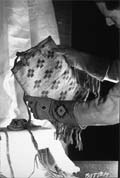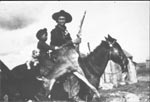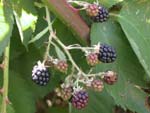 | | Blackberries along the Clearwater River |
By mid-summer and into early fall, the last of the camas had been dug and the berry picking begun. Families would travel to the higher hills and along the mountain creeks. Over twenty-two varieties of berries were gathered, with chokecherry (Prunus viginiana L.), huckleberry (Vaccinium membranaceum Dougl.), and serviceberries (Amelanchier alnifolia Nutt.) among the most important. As is the case prior to root digging, fishing, and game hunting, prayer would precede these activities. A common practice would be for an elder to face the direction of the highest mountain, and holding out a basket of freshly-picked berries, proceed to thank Amotqn, the Creator. In late fall the sqigwts or "water potato" (Sagittaia latifolia Willd.) is gathered along the marshy shores of Lake Coeur d'Alene. Of all the tribes of the region only the Schitsu’umsh gather this particular root.
A variety of baskets were fashioned, each type for a different purpose. Constructed from a single piece of cedar bark folded and sewn up its sides, the easily made cedar-bark basket was ideal for gathering berries. But to store the berries a ridged coiled-basket was fashioned from the roots of the red cedar tree. These were baskets that could be made water-tight and, after hot rocks were added, could cook foods in boiling water. These were baskets that would preserve roots and berries for many months, allowing these foods to be served year-round. Flexible twined flat and round bags were made from knee-spun Indian hemp and were used for root gathering and storing. The bags were often richly decorated with geometric designs of yellow, green and red dyed grasses and porcupine quills.
|
|
Hnmlmulsh - Place of Cottonwoods - Listen as Felix Aripa, Tribal Elder, tells of the gathering place and route taken by the various families as they began their travels into the mountians each year. (recorded and edited by John Hartman as part of the Coeur d'Alene Tribal GIS Names-Place Project) |
While still in the hills and mountains, intensive game hunting began. Among the most relied upon animals to be hunted were the white-tail deer (Odocoileus virginianus), mule deer (Odocoileus hemionus), elk (Cervus canadensis), moose (Alces alces), and black bear (Ursus americanus). Hunting was primarily a male activity. A unique method of deer hunting involved "drivers" who would herd the deer toward a water crossing or lake. At that water’s edge hunters in canoes would easily club, spear, or shoot the animals. A rather short, sinewed-back, recurved bow was used by the Schitsu’umsh hunters. It had amazing strength, which was well-adopted for hunting in the confines of forested areas. It was common for the deer or elk to be addressed as "Brothers," with the understanding that it was "offering itself up" to a deserving and respectful hunter. The venison and elk meat contributed a third of the traditional Schitsu’umsh diet.
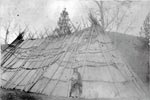 | | Tule-mat Longhouse. ca. 1890s |
With the snow and cold of winter pending, families would return to their village sites along the shores of Lake Coeur d’Alene and St. Joe, Coeur d’Alene and Spokane Rivers. There were some thirty-five of these semi-permanent villages, several populated with up to 300 individuals. The villages were comprised of the tule-mat "longhouses." They were up to 90 feet in length, constructed of lean-to structure and tule-mat covering. Each longhouse could accommodate several families, with each represented by a separate "fire pit."
It was during the long winter nights that the elders re-told the stories of Coyote, Crane, and Chief Child of the Yellow Root, and that the hunters and gatherers shared in their adventures of the past seasons. This was also the time for holding stick games in friendly competition between families. Communal deer hunting and ice fishing continued throughout the winter months. This was also the time for the culmination of the year's spiritual cycle - for holding the Winter Medicine Dances, also known as the Jump Dances. Suumesh songs were sung as the participants "jumped" to its beat and gave prayers. In so doing the dancers were themselves transformed into their Animal Spirits. Their prayers gave thanks for what had been so generously given during the previous seasons, and sought the same for the seasons to come. Winter was a time for learning, for prayer and thanksgiving, for laughter, and for renewing what it means to be Schitsu’umsh.
© Coeur d'Alene Tribe 2002
< previous |
next >
|



